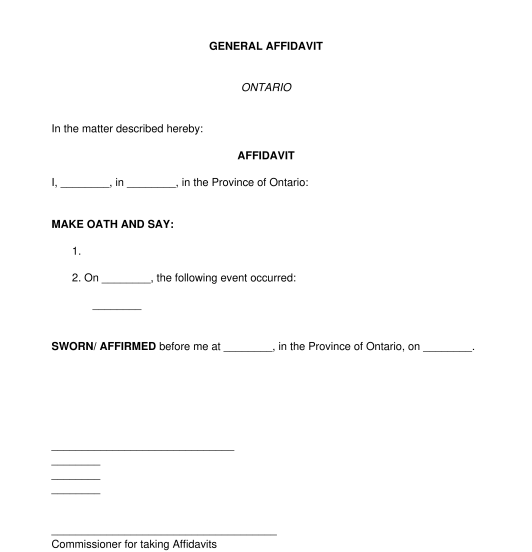 06/09/2025
06/09/2025

Answer a few questions and your document is created automatically.

Your document is ready! You will receive it in Word and PDF formats. You will be able to modify it.

An Affidavit is a document that a person uses to promise to tell the truth. The promise to tell the truth is either made under oath or affirmation:
They both have an identical legal effect, the breach of which is the criminal offence of perjury.
In other words, an Affidavit is a sworn statement made under oath or affirmation by an individual, called an affiant, who recounts a set of facts and swears that the contents of the document are true. An affidavit is commissioned by a commissioner of oaths and affidavits or a notary public. These are people authorized by law to witness Affidavits, which is a requirement. A simple Google search can be used to locate a local commissioner or notary.
The Affidavit states an individual's personal knowledge of a set of facts, which can sometimes include an opinion. The facts as presented must be accurate. The use of the Affidavit is typically for court purposes, or in anticipation of court, allowing a witness to describe the events.
For example, someone seen a consumer shopping at a store who slipped and fell. The person who saw the slip and fall can recount the facts stating when, how and where it happened in their Affidavit.
This document is for a general affidavit. Other affidavits may be used depending on the legal context. For example, an Affidavit of Execution may be used to swear on the execution of a legal document, including a Last Will and Testament or a Power of Attorney.
The document is small and simple to fill out.
This document may be filled out by any individual who wants to recount a set of facts. This is used as evidence to help prove a situation and to help describe events that happened at a certain time and place. Once the facts are recounted and the affiant signs the affidavit, a commissioner or notary signs the document in the presence of the affiant or virtually depending on the laws of the Province or Territory.
The Affidavit must be signed in front of a Commissioner or Notary. If the Commissioner or Notary isn't present, print out the document and wait to sign it in the presence of the Commissioner or Notary. Some Provinces and Territories permit remote signing.
Affidavits are used depending on the legal context. For example, when dealing with a lawsuit, the law requires the filing of Affidavits with the court. When dealing with a deceased's estate, the law requires the filing of an Affidavit of Execution to probate (prove) the Will of the deceased. An Affidavit is also used when changing a marital name or transferring title to property. The affiant in an Affidavit must be honest when recounting the facts. Lying under oath is a crime under the Criminal Code (R.S.C., 1985, c. C-46).
You fill out a form. The document is created before your eyes as you respond to the questions.
At the end, you receive it in Word and PDF formats. You can modify it and reuse it.
General Affidavit - Sample, template - Word & PDF
Country: Canada (English)